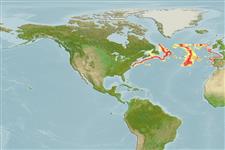Holocephali (chimaeras) >
Chimaeriformes (Chimaeras) >
Chimaeridae (Shortnose chimaeras or ratfishes)
Etymology: Hydrolagus: Greek, hydr = water + Greek, lagos = hare (Ref. 45335).
Environment / Climate / Range
Ecology
Marine; bathydemersal; depth range 300 - 3000 m (Ref. 4443). Deep-water, preferred ?; 55°N - 37°N
Northeast Atlantic: Rockall Trough along Ireland, northern Bay of Biscay and off Portugal. Reported from Iceland (Ref. 12462). Southwest Atlantic: Uruguay (Ref. 58839). Northwest Atlantic: Newfoundland in Canada to Cape Cod in USA. Probably has a much wider distribution. Possibly occurring off the Cape in South Africa and off Mozambique (Ref. 11228).
Size / Weight / Age
Maturity: Lm ? range ? - ? cm
Max length : 130 cm TL male/unsexed; (Ref. 4443); 125.0 cm TL (female)
Lacks a separate anal fin. Pectoral fin does not overlap pelvic fin. Short caudal filament. Dark brown in color (Ref. 6902).
Epibenthic (Ref. 58426). Found on continental slopes and down to deep-sea plains. Reported down up to 3000 m along the mid-Atlantic ridge (Ref. 83979, C.Cotton pers.comm. 03/10). Feeds on small fishes and invertebrates (Ref. 6680). Oviparous (Ref. 205). Eggs are encased in horny shells (Ref. 205).
Life cycle and mating behavior
Maturity | Reproduction | Spawning | Eggs | Fecundity | Larvae
Hardy, G.S. and M. Stehmann, 1990. A new deep-water ghost shark, Hydrolagus pallidus n.sp. (Holocephali, Chimaeridae), from the eastern North Atlantic, and redescription of Hydrolagus affinis (Brito Capello, 1867). Arch. Fisch. Wiss. 40(3):229-248. (Ref. 3330)
IUCN Red List Status (Ref. 115185)
CITES (Ref. 94142)
Not Evaluated
Threat to humans
Harmless
Human uses
Fisheries: of no interest
More information
ReferencesAquacultureAquaculture profileStrainsGeneticsAllele frequenciesHeritabilityDiseasesProcessingMass conversion
Tools
Special reports
Download XML
Internet sources
